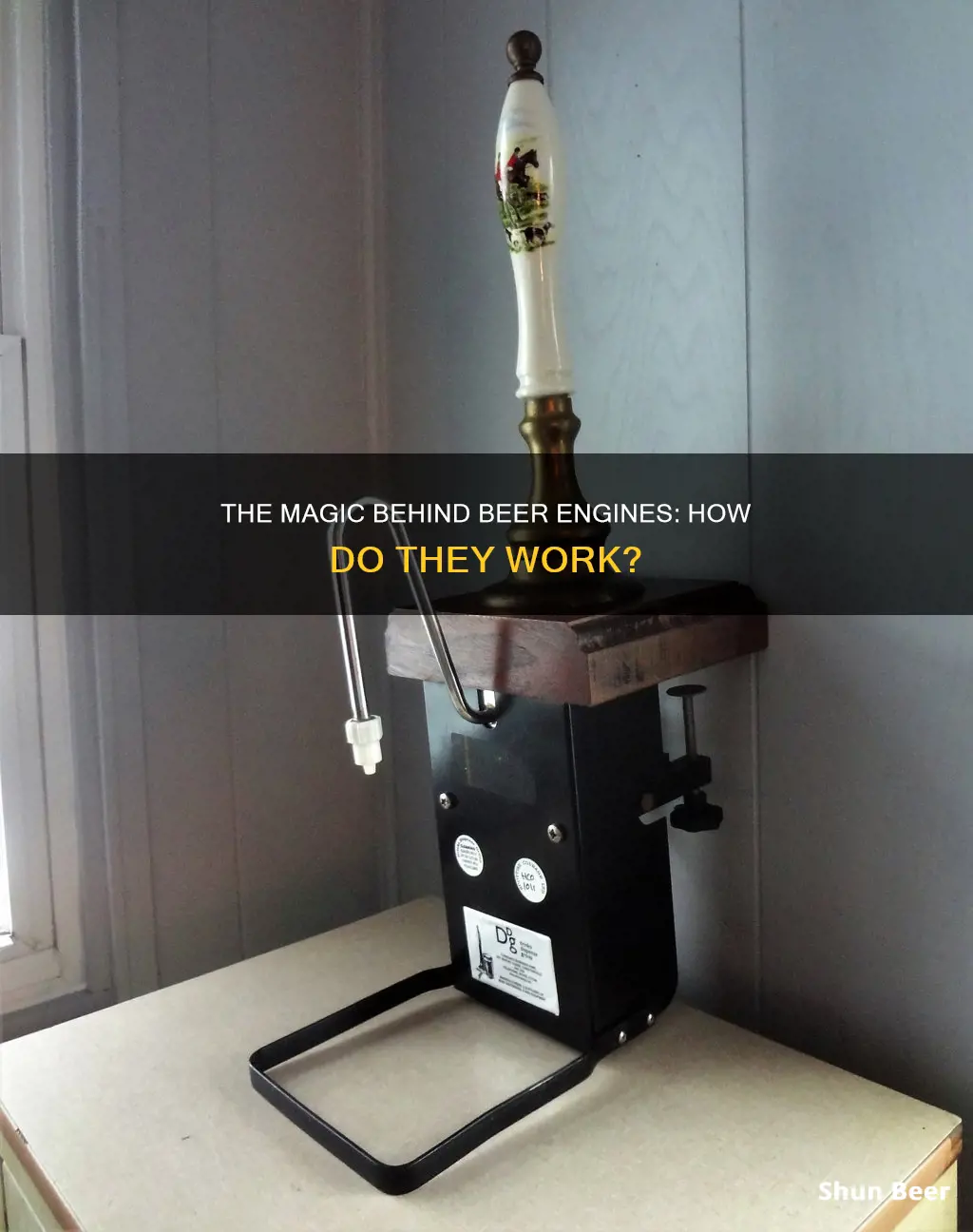
A beer engine, also known as a hand pump, is a device used to pump or draw beer from a cask. It is a uniquely British invention, dating back to the late 17th century, and specifically designed for traditional cask-conditioned ales. Beer engines allow the casks to be kept in a cooler cellar below the bar, with the beer pulled up to the bar by hand. This is in contrast to modern draft beer, which is typically poured from a keg using CO2 or beer gas to pressurise the keg and push the beer through the tap.
| Characteristics | Values |
|---|---|
| Definition | A beer engine, also known as a hand pump, is a device for pumping beer from a cask, usually located in a pub's cellar. |
| Inventor | John Lofting, a Dutch inventor, merchant and manufacturer who moved from Amsterdam to London in about 1688. |
| Year of Invention | 1688 |
| Other Inventions by the Inventor | Fire hose and engine for extinguishing fires, thimble knurling machine |
| Patented By | Joseph Bramah in 1797 |
| Power Source | Manual, electrical or gas |
| Location | Below the bar with the handle used to draw the beer through a flexible tube to the spout |
| Parts | Handle, drip tray holder, drip tray, sparkler, check valve, gas line, tubing |
| Function | Draws beer from a cask into the piston and then into a glass |
| Ideal for | Traditional cask-conditioned ales |
| Cask-Conditioned Beers Temperature | Served at about 11°C to 14°C (approximately 52°F to 57°F) |
| Cask-Conditioned Beers Carbonation | Lower carbonation than standard beers |
| Beer Engine Parts Material | Plastic or stainless steel (as mandated by a British law passed around 1990) |
| Beer Volume Dispensed | Half or a quarter (Imperial) pint per pull |
What You'll Learn

Beer engines are hand-operated pumps that draw beer from a cask or keg
A beer engine, also known as a hand pump, is a device used to draw beer from a cask or keg. It is a manual, piston pump that is specifically designed for traditional cask-conditioned ales. The beer engine allows the cask to be kept in a cooler cellar below the bar, while the beer is pulled or drawn up to the bar.
The mechanics of a beer engine are simple. At its heart is an airtight piston chamber. When the handle of the beer engine is pulled, beer is drawn from the cask into the piston. This may take several pulls, depending on the length of the beer line. A one-way valve holds the beer within the piston, and when the handle is pulled again, the beer in the piston flows out through another one-way valve to the tap as more beer is drawn into the piston chamber. A typical beer engine can draw about half a pint of beer with each pull of the handle.
Beer engines are often found in pubs, with the cask located in the cellar and the visible handle used to draw the beer through a flexible tube to the tap above the glass. Modern hand pumps may be clamped onto the edge of the bar or mounted on top of it.
The use of a beer engine is quite different from the U.S. custom of dispensing beer. "Real ale", as it is called by the Campaign for Real Ale (CAMRA), is dispensed from small kegs and pumped or poured directly from the keg to the glass, without the use of CO2 tanks or artificial carbonation. Real ale is also served at cellar temperature, around 54°F (12°C), similar to red wine.
Tanning with Beer: Does It Work?
You may want to see also

Beer engines are also known as handpumps
A beer engine is a device for pumping beer from a cask, usually located in a pub's cellar. It is also known as a hand pump or handpull. The beer engine was invented by John Lofting, a Dutch inventor, merchant and manufacturer who moved from Amsterdam to London in about 1688. He patented a number of inventions, including a fire hose and engine for extinguishing fires, and a thimble knurling machine.
The London Gazette of 17 March 1691 stated that Lofting had also patented a "very useful engine for starting of beers and other liquors which will deliver from 20 to 30 barrels an hour which are completely fixed with brass joints and screws at reasonable rates." The beer engine was further developed by the locksmith and hydraulic engineer Joseph Bramah in 1797.
The beer engine is usually manually operated, although electrically powered and gas-powered pumps are sometimes used. When manually powered, the term handpump is often used to refer to both the pump and its associated handle. The beer engine is typically located below the bar, with the visible handle being used to draw the beer through a flexible tube to the spout, where the glass is placed. Modern hand pumps may be clamped onto the edge of the bar or mounted on top of it.
A pump clip is usually attached to the handle, giving the name and sometimes the brewery, beer type, and alcoholic strength of the beer being served. The handle of a handpump is often used as a symbol of cask ale. This style of beer has continued fermentation and uses porous and non-porous pegs, called spiles, to release and retain the gases generated by fermentation, achieving the optimum level of carbonation in the beer.
Beer engines are specifically designed for traditional cask-conditioned ales, which have a lower level of carbonation than standard beers because they are served at a warmer temperature. If a cask-conditioned ale were served through a standard dispensing system, the colder temperature and higher gas pressure would increase the carbonation of the beer, causing it to lose its ideal balance of flavours. Conversely, dispensing fully carbonated beers with a beer engine would result in relentless foam.
Operating a beer engine requires physical strength, skill, and patience. Experienced bartenders will use both their right and left arms to pull pints to avoid the so-called "barman's bicep", where one arm becomes noticeably larger than the other.
Beer's Blood-Thinning Effect: Myth or Reality?
You may want to see also

Beer engines are designed for cask-conditioned ales
Beer engines, also known as hand pumps, are designed for cask-conditioned ales. Cask-conditioned ales are unfiltered and have live yeast in the cask, which is how they achieve their final fermentation and carbonation. This type of ale is typically served at a warmer temperature than standard beers, at around 52°F to 57°F.
If a cask-conditioned ale were served through a standard dispensing system, the colder temperature and gas pressure would increase the carbonation of the beer, causing it to lose its ideal balance of flavours. Conversely, if a fully carbonated beer were dispensed using a beer engine, it would yield relentless foam. Therefore, a beer engine is specifically designed to dispense cask-conditioned ales.
The beer engine was invented by John Lofting, a Dutch inventor, merchant and manufacturer who moved from Amsterdam to London in about 1688. He patented a number of inventions, including a fire hose and engine for extinguishing fires. The London Gazette of 17 March 1691 stated that Lofting had invented a "very useful engine for starting of beers and other liquors which will deliver from 20 to 30 barrels an hour".
The beer engine was further developed by Joseph Bramah, a locksmith and hydraulic engineer, in 1797. The modern beer engine has changed little since the early 1800s. It consists of a simple piston attached to a long, sturdy handle, with check valves that ensure beer flows in one direction, from the cask to the glass.
Do Sulfite Wands Really Work for Beer?
You may want to see also

Beer engines use a piston pump and cylinder to draw beer
A beer engine, also known as a hand pump, is a dispensing device that is specifically designed for traditional cask-conditioned ales. It is a piston pump that allows casks to be kept in a cooler cellar beneath the bar while the beer is pulled or drawn up to the bar.
The mechanics of a beer engine are simple. At its core is an airtight piston chamber. When the bartender pulls the beer engine handle, beer is drawn from the cask into the piston. This may take several pulls, depending on the length of the beer line. A one-way valve, or a check valve, ensures that the beer remains within the piston. When the handle is pulled again, the beer in the piston flows out through another one-way valve to the beer engine's tap, while more beer is simultaneously drawn to fill the piston chamber. Typically, a beer engine can draw about half a pint of beer with each pull of the handle.
To set up a beer engine, it is important to understand how it works. Beer engines create a vacuum by sucking the beer out of the vessel it is in. Therefore, the vessel needs to have an inlet valve. If you plan on drinking all the beer, you can simply remove the lid or cap to allow airflow. However, doing so will expose the beer to ambient oxygen, which will cause it to spoil. To prevent this, a cask with a CO2 tank attached can be used. This will replace the beer that has been dispensed with CO2, keeping the remaining beer fresh for longer.
To use the beer engine, a check valve is required. This check valve uses a 5/16 gas line to connect the keg to the regulator inlet, and a 1/2 inch tube to connect the regulator outlet to the beer engine. This setup allows the piston in the beer engine to draw the beer into the system.
Underground Beer Coolers: Do They Keep Drinks Chilled?
You may want to see also

Beer engines can be difficult to clean
A beer engine, also known as a hand pump, is a device used to pump beer from a cask, usually located in a pub's cellar. The beer is manually pulled or drawn up from the cask to the bar through a beer line.
To clean a beer engine without disassembling it, you can use a cleaning solution such as beer line cleaner, which can be purchased from brewing supply stores or online. Dilute the cleaner as recommended and pull it through the lines and engine with the pump handle. Leave it to soak for 20 minutes before flushing the system with clean water. Repeat this process until the liquid runs clear.
Some cleaning solutions are coloured, which can help you determine when the beer engine is clean. For example, Prosan Ultra turns purple when mixed with water and then changes colour from yellow to green to blue as it cleans, turning clear once the job is done.
If you are able to disassemble your beer engine, it is recommended to do so as it allows for a more thorough cleaning. Pay close attention to the cylinder, swan neck, and tail at the input to the cylinder, as these areas tend to collect dirt and residue. Soaking these parts in a cleaning solution and then giving them a light scrub will help remove any built-up grime.
Remember to always clean your beer engine regularly, especially if it has not been used in a while, to prevent the build-up of old beer residue and ensure your beer remains palatable.
Beer as Petrol: Can You Really Run on Hops?
You may want to see also
Frequently asked questions
A beer engine, also known as a hand pump, is a device used to pump or draw beer from a cask, usually located in a pub's cellar.
The beer engine is a piston pump with an airtight piston chamber at its heart. When the handle is pulled, beer is drawn from the cask into the piston through a one-way valve. Pulling the handle again releases the beer from the piston through another one-way valve to the tap, while simultaneously drawing more beer into the piston chamber.
Beer engines are specifically designed for traditional cask-conditioned ales, which have lower carbonation and are served at a warmer temperature than standard beers. The beer engine allows the cask to be kept in a cooler cellar below the bar while still dispensing the beer at the bar.
The beer engine was invented by John Lofting, a Dutch inventor who moved to London in 1688. He patented the device in 1691, describing it as "a very useful engine for starting of beers and other liquors." The design was further developed by Joseph Bramah in 1797.
The beer engine is typically located below the bar, with the handle used to draw the beer through a flexible tube to the tap above. Modern hand pumps may be clamped to the edge of the bar or mounted on top of it. The beer engine creates a vacuum to suck the beer out of the cask, so an inlet valve or a CO2 tank is needed to replace the displaced beer and prevent oxidation.







